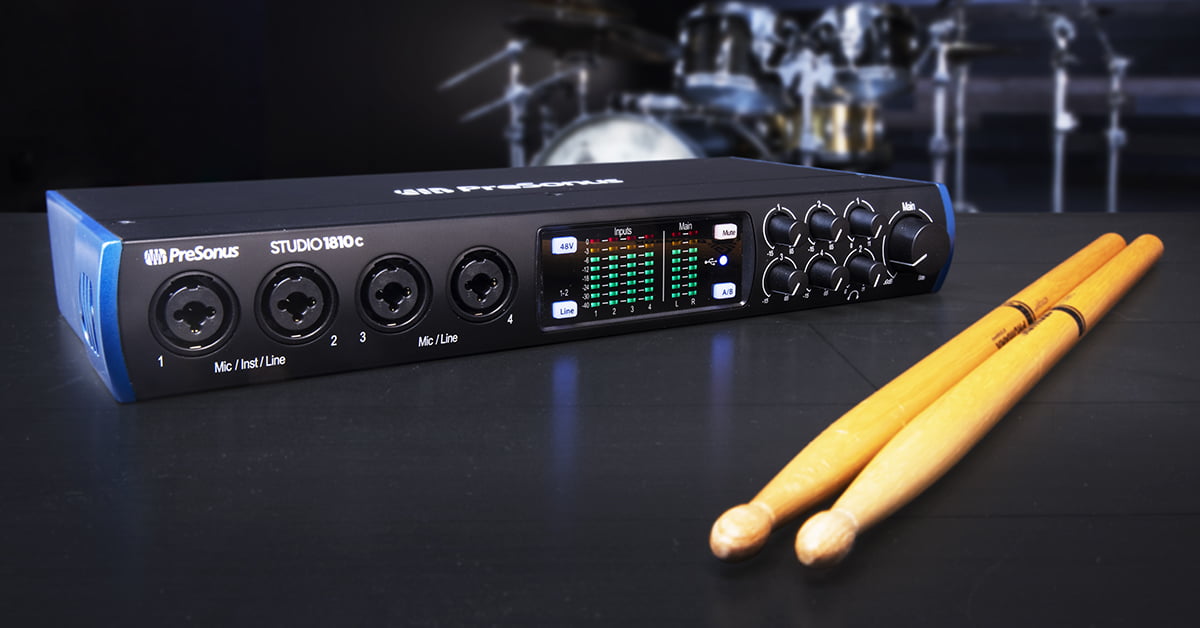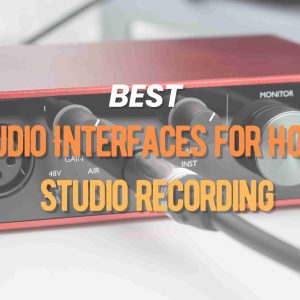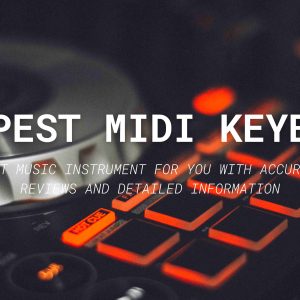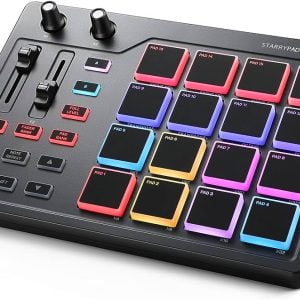The best audio interfaces are devices that connect with your computer to enhance the audio quality of your recordings and playback with low latency. With a multitude of options available, finding the right one can seem daunting, but this article aims to simplify the process by highlighting some of the top audio interfaces on the market.
Table of Contents ( Best Audio Interfaces )
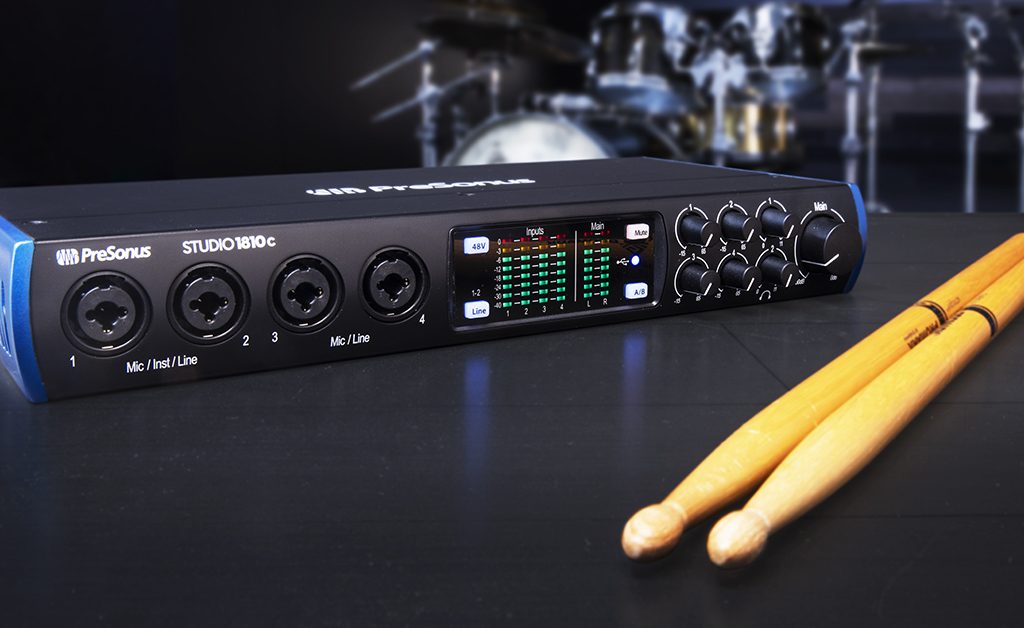
We will discuss their key features, compatibility, and overall performance to help you make an informed decision. Whether you are a musician, podcaster, or content creator, having a quality audio interface is essential for achieving professional sound quality. So, let’s dive in and explore the best options available to take your audio production to the next level.
Key Factors To Consider When Choosing The Best Audio Interface
When it comes to recording audio, having a high-quality audio interface is essential. The audio interface serves as the bridge between your instrument or microphone and your computer, ensuring that the sound is captured accurately and with minimal latency. With so many options available in the market, it can be overwhelming to choose the best audio interface for your needs. In this article, we will discuss the key factors that you should consider when making your decision.
Input And Output Options
One of the first things you should consider when choosing an audio interface is the number and type of input and output options it offers. The inputs are where you connect your instruments or microphones, while the outputs are where you connect your speakers or headphones. Having a variety of input options such as XLR, ¼” TRS, and MIDI allows you to capture a wide range of audio sources. Similarly, having multiple output options such as TRS and RCA ensures that you can connect your audio interface to different types of studio monitors or headphones.
Connectivity And Compatibility
The next factor to consider is the connectivity and compatibility of the audio interface. The most common type of connection used is USB, which is widely compatible with both Mac and PC. However, if you are using a newer Mac device, you might want to consider an audio interface with Thunderbolt connectivity, as it offers faster data transfer rates and lower latency. It is also important to check if the audio interface is compatible with your operating system and recording software to avoid any compatibility issues.
Sampling Rate And Bit Depth
Sampling rate and bit depth are two important specifications that determine the quality of audio you can capture with your interface. The sampling rate refers to the number of audio samples captured per second and is typically measured in kilohertz (kHz) or megahertz (MHz). Higher sampling rates result in more accurate audio reproduction. The bit depth, on the other hand, refers to the number of bits used to represent each audio sample. Higher bit depths allow for greater dynamic range and audio resolution. When choosing an audio interface, it is recommended to opt for higher sampling rates (such as 96kHz or 192kHz) and higher bit depths (such as 24-bit) for optimal audio quality.
Preamps And Converters
The preamps and converters are critical components of an audio interface that impact the sound quality of your recordings. Preamps amplify the low-level signals from your microphone or instrument, ensuring that they can be accurately captured by the converters. High-quality preamps provide clean and transparent amplification, while lower-quality preamps may introduce noise or coloration to the audio. Converters, on the other hand, convert the analog signals from your instruments or microphones into digital audio that can be processed by your computer. The quality of the converters affects the accuracy and fidelity of the captured audio. Look for an audio interface with high-quality preamps and converters to ensure professional-grade sound capture.
Top Picks: Best Audio Interfaces For Home Studios
When it comes to setting up your home studio, having a reliable and high-quality audio interface is essential. An audio interface acts as the bridge between your computer and your musical instruments or microphones, allowing you to capture and record professional-grade audio. In this article, we will discuss the top picks for the best audio interfaces for home studios, focusing on three highly acclaimed models: the Focusrite Scarlett 2i2 (3rd Gen), the PreSonus AudioBox USB 96, and the Universal Audio Apollo Twin MKII. Let’s dive in and explore what makes these audio interfaces stand out from the competition.
Focusrite Scarlett 2i2 (3rd Gen)
The Focusrite Scarlett 2i2 (3rd Gen) is a compact and robust audio interface that has gained immense popularity among home studio owners and professional musicians alike. With its two high-performance preamps and best-in-class conversion, the Scarlett 2i2 allows you to capture studio-quality recordings with exceptional detail and clarity. Its sleek design and intuitive controls make it easy to use, even for beginners.
Key Features of the Focusrite Scarlett 2i2 (3rd Gen) include:
- Two high-performance Scarlett preamps with switchable Air mode to add brightness and space to your recordings
- Upgraded 24-bit/192kHz AD-DA converters for pristine sound quality
- Low-latency USB-C interface for seamless audio streaming and monitoring
- Easy-to-use and comprehensive software bundle, including Focusrite Control, Ableton Live Lite, Pro Tools First Creative Pack, and more
Presonus Audiobox Usb 96
The PreSonus AudioBox USB 96 is another excellent choice for home studio owners who are looking for a reliable and budget-friendly audio interface. This compact yet powerful device offers a balanced combination of features and performance, making it a popular choice for musicians, podcasters, and content creators.
Key Features of the PreSonus AudioBox USB 96 include:
- Two high-quality mic/instrument preamps with switchable 48V phantom power
- 24-bit resolution and 96kHz sampling rate for crystal-clear audio recordings
- Zero-latency monitoring to ensure accurate performances during recording
- Seamless integration with PreSonus Studio One Artist DAW software
Universal Audio Apollo Twin Mkii
The Universal Audio Apollo Twin MKII is a top-of-the-line audio interface beloved by professional producers and engineers around the world. This interface boasts the renowned UAD Powered Plug-Ins with near-zero latency performance, allowing you to enhance your recordings with industry-standard effects and processing.
Key Features of the Universal Audio Apollo Twin MKII include:
- Two premium-quality Unison preamps for capturing the true tone and characteristics of iconic analog devices
- Realtime UAD Processing for running UAD Powered Plug-Ins with virtually no latency
- High-resolution 24-bit/192kHz audio conversion for immaculate sound quality
- Thunderbolt connection for ultra-fast data transfer and low-latency performance
In conclusion, the Focusrite Scarlett 2i2 (3rd Gen), PreSonus AudioBox USB 96, and Universal Audio Apollo Twin MKII are three exceptional audio interfaces that offer a wide range of features and excellent recording capabilities. Whether you are a beginner or a seasoned professional, investing in any of these audio interfaces will undoubtedly elevate the quality of your home studio recordings.
Best Audio Interfaces For Professional Studios
In a world where audio quality is of utmost importance, professional studios rely heavily on top-notch audio interfaces. These powerful devices serve as the heart and soul of any recording setup, responsible for translating audio signals into digital data. With so many options available in the market, it can be overwhelming to choose the right audio interface for your professional studio. To help you make an informed decision, we have curated a list of the best audio interfaces that deserve a place in every professional studio. Read on to discover the top contenders:
Apogee Symphony I/o Mkii
Designed to elevate your recording and mixing experience, the Apogee Symphony I/O MKII sets itself apart with its exceptional audio quality and flexible I/O options. This audio interface boasts impressive specifications that are sure to impress even the most discerning sound engineers. With its advanced converter technology, the Symphony I/O MKII delivers pristine audio reproduction, capturing every detail of your sound with stunning accuracy. Its extensive connectivity options, including Thunderbolt and USB, ensure seamless integration with your existing studio setup.
Additionally, the Symphony Control software provides a user-friendly interface, allowing you to easily configure and fine-tune your audio settings. Whether you’re recording vocals, instruments, or mixing tracks, the Apogee Symphony I/O MKII is a reliable and high-performing choice for professional studios.
Rme Audio Fireface Ufx
The RME Audio Fireface UFX is a powerhouse audio interface that combines superb sound quality with an extensive feature set. This interface offers an impressive number of inputs and outputs, making it ideal for large-scale recording sessions. With its low-latency performance and high-resolution audio capabilities, the Fireface UFX ensures that every audio signal is captured with clarity and precision.
The TotalMix FX software provides comprehensive control over your audio routing and monitoring, giving you the flexibility to create complex setups tailored to your studio’s unique requirements. Not only does the Fireface UFX excel in audio quality, but it also offers robust build quality and reliable performance, making it a popular choice among professional studios.
Antelope Audio Orion Studio Synergy Core
The Antelope Audio Orion Studio Synergy Core is a cutting-edge audio interface that promises to revolutionize your studio workflow. This interface is powered by Antelope Audio’s acclaimed Synergy Core DSP and FPGA processing, delivering unparalleled sound processing capabilities. With its extensive collection of high-quality analog emulations, including EQs, compressors, and reverbs, the Orion Studio Synergy Core allows you to achieve premium analog sound within your digital workspace. Featuring an impressive array of connectivity options and ultra-low latency performance, this interface is a versatile tool for any professional studio. With its sleek design and intuitive control panel, the Orion Studio Synergy Core seamlessly combines style and functionality, making it a standout choice for discerning sound engineers.
Best Portable Audio Interfaces For On-the-go Recording
If you’re an on-the-go musician or content creator, having a reliable and portable audio interface is crucial for capturing high-quality recordings anytime, anywhere. In this blog post, we’ll explore three of the best portable audio interfaces that offer stellar performance and versatility for on-the-go recording. Whether you’re a musician, podcaster, or YouTuber, these audio interfaces will ensure that you never miss a creative moment. Let’s dive in and discover the top picks for portable audio interfaces:
Zoom H6 Handy Recorder
The Zoom H6 Handy Recorder is a powerhouse when it comes to portable audio interfaces. This compact device features a top-quality XY stereo microphones and four XLR/TRS inputs, allowing you to connect multiple instruments or external microphones simultaneously. With its sleek design and intuitive interface, the Zoom H6 Handy Recorder is perfect for recording on the go.
Audient Id14
The Audient iD14 is another excellent choice for those in need of a portable audio interface. This compact interface offers exceptional audio quality with its class-leading mic preamps and pristine AD/DA converters. With its robust build and easy-to-use controls, the Audient iD14 is designed to withstand the demands of mobile recording while delivering professional-grade results.
Motu Ultralite-mk4
The MOTU UltraLite-mk4 is a powerful and feature-packed portable audio interface that caters to the needs of professionals and enthusiasts alike. With its impressive I/O options, including ten inputs and fourteen outputs, this interface offers incredible flexibility for on-the-go recording. Coupled with its low-latency performance and superb audio quality, the MOTU UltraLite-mk4 is a go-to option for musicians and content creators.
Audio Interfaces For Different Budgets: Affordable Options
When it comes to setting up a home recording studio, having a reliable audio interface is essential. Whether you’re a budding musician, a podcast enthusiast, or a content creator, a good audio interface can greatly improve the quality of your recordings. The good news is that you don’t have to break the bank to get a great audio interface. In this article, we’ll explore three affordable options that deliver on both price and performance. Let’s take a closer look at the Behringer U-Phoria UM2, M-Audio M-Track 2X2, and Native Instruments Komplete Audio 2.
Behringer U-phoria Um2
The Behringer U-Phoria UM2 is a popular choice for beginners due to its affordable price and quality features. This compact audio interface offers 2 inputs and 2 outputs, making it perfect for solo musicians or podcasters. With its combination XLR/TRS inputs, you can connect a microphone or line-level device effortlessly. The UM2 also includes a +48V phantom power supply, allowing you to connect studio-quality condenser microphones. It supports sample rates up to 48kHz and offers a direct monitoring feature for latency-free recording. The Behringer U-Phoria UM2 is a fantastic option for those on a tight budget without compromising on sound quality.
M-audio M-track 2×2
The M-Audio M-Track 2X2 is a reliable and versatile audio interface that delivers excellent value for its price. With its all-metal construction, it’s both sturdy and stylish. The 2X2 features 2 combo inputs with Crystal preamps, allowing you to connect microphones, guitars, or line-level devices. It also offers +48V phantom power for condenser microphones. With its high-definition 24-bit/192kHz audio resolution, you can expect crystal-clear recordings. The 2X2 also comes with a dedicated headphone output with independent level control, ensuring accurate monitoring. Whether you’re recording vocals, instruments, or podcasts, the M-Audio M-Track 2X2 is a fantastic choice for budget-conscious individuals.
Native Instruments Komplete Audio 2
If you’re looking for an audio interface that combines affordability with professional-grade features, look no further than the Native Instruments Komplete Audio 2. This sleek and compact interface offers premium sound quality at an accessible price point. The Komplete Audio 2 boasts 2 combo inputs with onboard preamps, allowing you to capture both microphones and line-level instruments. Its transparent, low-noise performance ensures pristine recordings. With its 24-bit/192kHz resolution, you can expect studio-quality sound. The Komplete Audio 2 also includes a headphone output with independent volume control and a direct monitoring option for zero-latency recording. Whether you’re a musician, producer, or streamer, the Native Instruments Komplete Audio 2 offers exceptional value for your money.
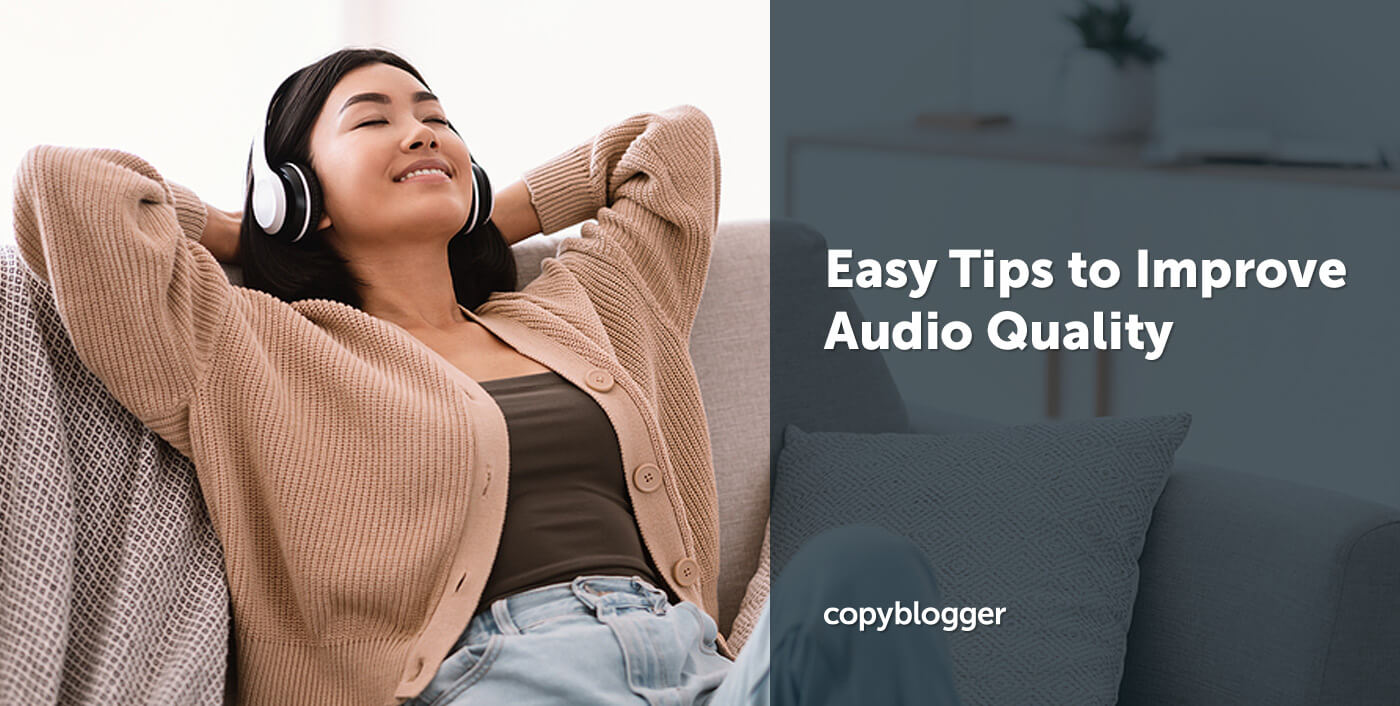
Credit: copyblogger.com
Troubleshooting Common Audio Interface Issues
When it comes to audio interfaces, even the best ones might encounter common issues that can be frustrating for the user. This section will address some of the most frequently encountered problems and provide solutions to troubleshoot them effectively. By understanding how to overcome these obstacles, you can optimize your audio interface’s performance and ensure a seamless recording or playback experience.
Driver Compatibility And Updates
One of the primary causes of audio interface issues lies in driver compatibility and updates. Drivers act as a bridge between the audio interface and the computer’s operating system, allowing them to communicate effectively.
It is crucial to ensure that the audio interface’s drivers are compatible with your operating system. Check the manufacturer’s website for the latest driver updates, as they often address bugs, compatibility issues, and optimize performance. Installing the latest drivers can significantly enhance the stability and functionality of your audio interface.
Buffer Size And Latency Issues
The Buffer size and latency can directly impact the performance and responsiveness of your audio interface. Buffer size refers to the amount of audio data that is stored in the interface’s buffer before it is sent to the computer for processing.
A smaller buffer size can reduce latency, but it also puts more strain on your computer’s processor. Conversely, a larger buffer size allows for smoother processing but increases latency. Finding the optimal balance between the two is crucial to preventing audio dropouts, glitches, and latency issues.
To troubleshoot buffer size and latency issues, you can adjust the buffer settings in your audio interface’s control panel or software. Experiment with different buffer sizes to find the ideal setting that minimizes latency without overburdening your computer’s processor.
Noise And Signal Interference
Noise and signal interference can be detrimental to audio quality. Interference can manifest as unwanted background noise, hum, buzz, or clicks in your recordings or playback.
Signal interference can occur due to various factors, including electrical devices, cables, or even nearby wireless signals. To address this issue, follow these steps:
- Ensure that all cables are securely connected and not damaged.
- Avoid running audio cables alongside power cables or other sources of electrical interference.
- Use shielded cables to minimize the impact of external interference.
- Consider using a power conditioner or surge protector to minimize electrical noise.
- Position your audio interface away from electrical devices and sources of interference.
By implementing these steps, you can mitigate noise and signal interference, resulting in cleaner and more professional audio recordings.
Frequently Asked Questions For Best Audio Interfaces
What Audio Interface Has The Best Sound Quality?
The audio interface with the best sound quality is subjective and can vary depending on individual preferences and needs. It is recommended to research and compare different brands and models to find one that suits your specific requirements. Some popular options known for their excellent sound quality include Focusrite Scarlett, Universal Audio Apollo, and Apogee Duet.
Why Is Focusrite So Popular?
Focusrite is popular because it offers high-quality audio interfaces that musicians and creators trust. Its excellent sound performance, user-friendly software, and reliable build make it a top choice in the industry. Its commitment to innovation and customer satisfaction has contributed to its widespread popularity.
Are More Expensive Audio Interfaces Better?
Expensive audio interfaces are not necessarily better. Quality depends on various factors like brand, features, and user requirements. It’s important to consider the specific needs and budget when making a decision.
Is It Better To Listen To Music Through An Audio Interface?
Listening to music through an audio interface can enhance sound quality and provide professional-grade audio. It improves audio signal conversion and minimizes latency for a better listening experience.
Conclusion
After exploring the top audio interfaces available, it’s clear that these devices play a crucial role in enhancing your music production experience. With their advanced features and high-quality audio processing capabilities, audio interfaces can help you achieve professional sound recording and mixing.
Remember to consider your specific needs and preferences when selecting the best audio interface for your setup. Whether you’re a beginner or a professional, finding the right interface can take your music production to the next level. So, start creating amazing music with the best audio interface that suits your requirements!
For read our more blogs, Click Here

